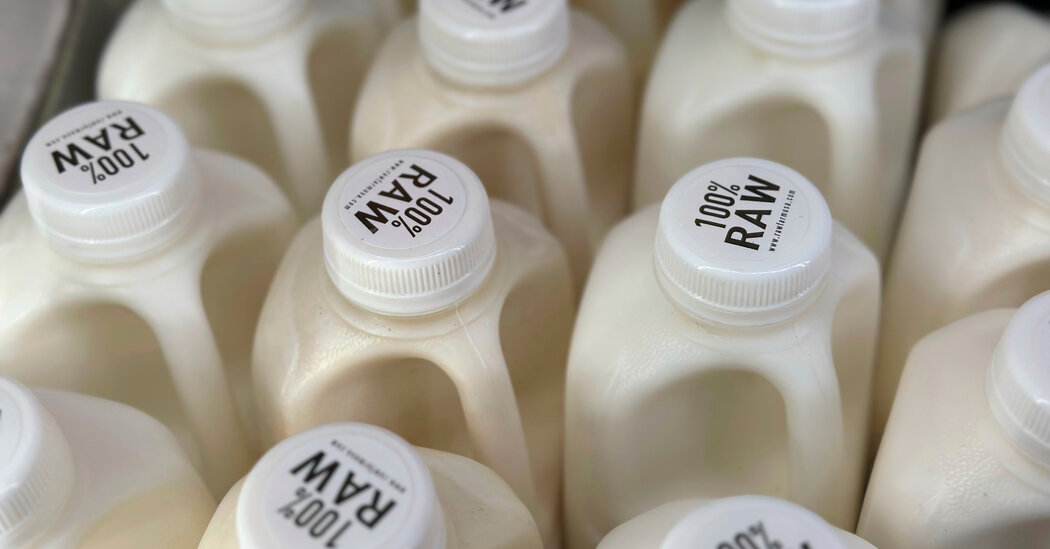
Unpasteurized milk contaminated with the H5N1 virus, the avian flu virus that has appeared on dairy farms in nine states, was found to make mice rapidly sick, affecting multiple organs, according to a study released Friday.
The findings aren't entirely surprising: At least half a dozen cats have died after consuming raw milk containing the virus. But new data confirms that virus-laden raw milk may not be safe for other mammals, including humans.
“Don't drink raw milk: That's the message,” said Yoshihiro Kawaoka, a virologist at the University of Wisconsin, Madison, who led the study.
Most commercial milk in the United States is pasteurized. The Food and Drug Administration found traces of the virus in 20% of dairy products sampled from supermarket shelves nationwide. Officials found no signs of infectious virus in those samples and said the pasteurized milk is safe to consume.
But the findings have global implications, said Dr. Nahid Bhadelia, director of the Center for Emerging Infectious Diseases at Boston University, who was not involved in the work.
“If the epidemic spreads further among cows, there will be more places where centralized pasteurization doesn't exist,” he warned, “and there are many more rural communities drinking milk.”
In the study, Dr. Kawaoka and his colleagues analyzed the virus from milk samples from an affected dairy herd in New Mexico. The researchers found that levels of the virus slowly decreased in a milk sample stored at 4 degrees Celsius, suggesting that H5N1 in refrigerated raw milk can remain infectious for several weeks. The results were published in the New England Journal of Medicine.
Flu viruses survive refrigerator temperatures well, and milk proteins also help stabilize them, said Richard Webby, a flu expert at St. Jude Children's Research Hospital in Memphis, who was not involved in the work .
If people who drink raw milk believe that refrigeration kills the virus, “that clearly shows that it doesn't,” Dr. Webby said.
Mice fed the contaminated milk quickly became ill, exhibiting matted fur and lethargy. On the fourth day, the mice were euthanized, and researchers found high levels of virus in the respiratory system and moderate levels in several other organs. Like the infected cows, the mice also harbored the virus in their mammary glands – an unexpected discovery.
“These mice are not lactating mice; however the virus can be found in the mammary glands,” Dr. Kawaoka said. “It's very interesting.”
It's unclear whether the presence of the virus in the mammary glands is a characteristic of this particular virus or of avian influenza viruses in general, Dr. Webby said: “We're learning new things every single day.” Mice are common pests on livestock farms and provide another potential host for the virus, and cats and birds that feed on infected mice could also become ill.
Cats who died after drinking contaminated milk showed striking neurological symptoms, including stiff body movements, blindness, a tendency to walk in circles, and a weak blink response. If the mice had been allowed to live longer, they might have developed similar symptoms, Dr Webby said.
It is also unclear what the findings mean for the course of the infection in people. On Wednesday, federal officials announced that a second dairy worker had tested positive for the H5N1 virus; a nasal swab from that person tested negative for the virus, but an eye swab tested positive.
Pasteurization kills germs by heating milk to high temperatures. In the new study, when the researchers heated the milk to the temperatures and time periods typically used for pasteurization, the virus was either undetectable or greatly diminished, but it was not completely inactivated.
Dr Kawaoka cautioned that laboratory conditions were different to those used in commercial pasteurization, so the results did not mean milk on supermarket shelves contained active viruses.
By contrast, the finding that raw milk contains large amounts of the virus is “robust,” he said.
Raw milk has become popular in recent years as wellness gurus and right-wing commentators have extolled its supposed virtues, even more so since the avian flu outbreak began in dairy cows. Some say it tastes better and is more nutritious than pasteurized milk. Others claim that it increases immunity.
In contrast, pasteurization preserves calcium, the key nutrient in milk, and adds vitamin D to aid absorption. According to the Centers for Disease Control and Prevention, consuming raw milk can lead to serious complications or even death from a variety of pathogens, especially in people with weakened immune systems.
From 1998 to 2018, outbreaks linked to raw milk consumption led to 228 hospital admissions, three deaths and illness in more than 2,600 people.
